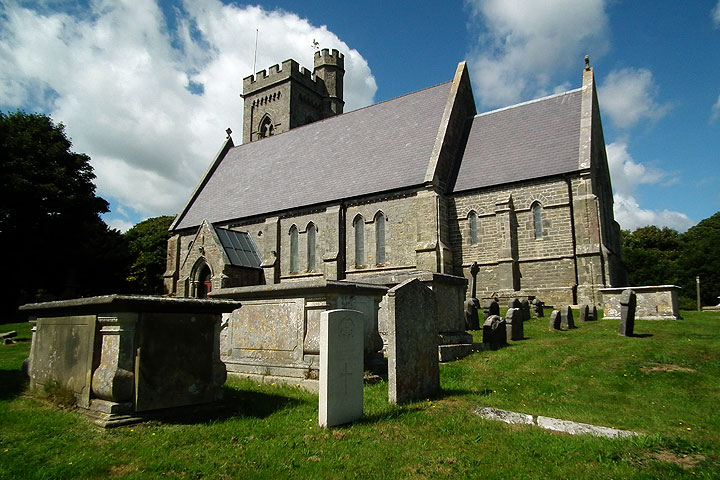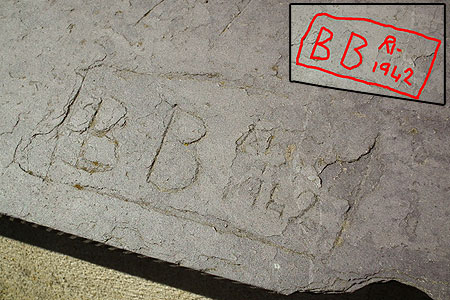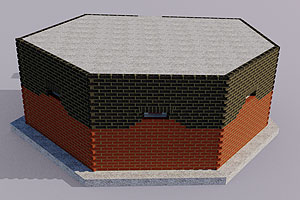A pleasant surprise at Fairlight
Posted: 14 August 2011 23:39
A trip to Fairlight to locate a few wartime features and research an incident brought about an unexpected opportunity and a chance discovery.
This has been the first excursion I've blogged on the day it happened in a very long time.
Unfortunately I've had very little time to spend on such activities in the past year as I've been run ragged with my daytime job and devoting evenings and weekends to an academic qualification that's driving me insane.

As usual, I'm weeks behind on admin and emails and so I decided that today would constitute my summer holiday for this year.
I've been meaning to visit Fairlight for some time; situated on high ground between Hastings and Rye, the area saw a lot of activity during the war.
My intention was to research a flying bomb incident in 1944, but my first stop was at St. Andrew's Church to locate a grave.
I mentioned the tragic loss of Private P. Gabbitas in my Remembrance piece last November.
Peter Gabbitas died as a result of falling off the cliffs at Fairlight on January 27, 1941, the second fatality in as many days from the ranks of the Royal Sussex Regiment.
I was also looking for the various minefields that were laid here; again, lives were lost as a result of them.
Although I had a series of minefield maps with me, time was short, and because I'm not very familiar with the area I decided to abandon this aspect from my list of objectives for today.
Such mined areas as I did identify are hard to appreciate on my photos (aside from the one below) due to the sheer volume of gorse bushes covering the terrain.

Fairlight was home to a CHL (Chain Home Low) radar station based around the coastguard cottages; the site is still used in conjunction with some sort of radar equipment.
As the station was listed as a Vulnerable Point, in 1942 the grassed area in the photo was sown with 470 mines.
Just 12 weeks after the field was laid, two mines detonated, followed by another eight days later and a fourth four days later.
The occupying guard detachment could not locate any craters and it was assumed the detonations had been caused by rabbits fouling the wires that allowed the mines to be recovered.
A feature I've yet to find in the area is slit trenches; I did see several lumps and bumps, but nothing positively identified.
Finally, to the pleasant surprise! As I was driving out of the car park, I looked up and saw people up in the church tower.
A quick u-turn back into the car park, pay-and-display ticket rescued from the ashtray and returned to the windscreen and I went to see if the tower was open to the public. To my delight, it was. The photo below shows the church looking NW; Private Gabbitas' headstone is in centre foreground.

What's so special about getting up a church tower? Firstly, the view of the surrounding landscape, but also that Fairlight Church tower was used as an observation post (OP) and some senior figures visited it.
According to the war diary, on 27 October 1941 Lt-General Paget, (Commanding Officer of South Eastern Command) "stopped at Fairlight Church and climbed to the OP in the tower but visibility was insufficient to permit the best view of the Brigade area."
Two days later, General McNaughton (C.O. of the Canadian Corps) also dropped by: "When climbing the church tower, General McNaughton remarked that he had last been there in 1927."
I've deliberately not yet mentioned the view from Fairlight, which, even from the ground is staggering. Climb the church tower and you see why it was an OP and why senior officers visited in order to appreciate the lie of the land in this sector. On a clear day, you can apparently see approximately 2,500 square miles - from Eastbourne to the west to Dover in the East, the French coast to the south and deep into the Sussex Weald and hinterland.
The photo below shows how the tactical situation can be appreciated. The progress of an invasion force at Rye could be observed. Ringed is the Battery Observation Post on Toot Rock, Pett.



An unexpected bonus was the discovery of some WW2 graffiti etched into the roofing slate.
The text above the date is all but illegible, but if it originally read 'RHLI', then it would tie in with the Canadian Royal Hamilton Light Infantry, who were here 1941-42.
It may have been a civilian who etched this; there is a lot of older graffiti carved into the stone, but other OPs I've seen bear the mark of idle hands on watch duty.
It's also questionable whether once the military had established an OP here, civilians would have access to it.
After spending some time appreciating the view, I made my way down, glad of an unexpected addition to the day's itinery.
I went off to investigate the flying bomb incident I mentioned, and will post this as separate piece as and when I can find time!
- Pete

Email:
Blog Latest

Bishopstone reveals its pillbox secrets
18 October 2021

Pillbox or Observation Post?
10 June 2020

Uncovering the hidden secrets of a pillbox
8 June 2019

Review of 2018
31 December 2018

Wartime Christmas in East Sussex (2)
24 December 2018
Jargon-buster
Battery Observation Post
A fire control centre for a gun battery, the term is usually synonymous with Emergency Coast Defence batteries. A BOP might be purpose-built or be established in an existing building, such as a Martello Tower. The BOP usually housed a range-finder as well as a Dumaresq fire control computer.
Slit trench
Small, narrow trench designed to provide protection against shrapnel and other battlefield hazards. Technically distinct from a weapon pit (which was intended soley as a defensive position) slit trenches were also used as defence works.
War diary
A record of events kept by all units from the point of mobilisation. A diary's contents vary enormously from unit to unit; some give detailed entries by the hour on a daily basis while others merely summarise events on a weekly/monthly basis.
This site is copyright © Peter Hibbs 2006 - 2024. All rights reserved.
Hibbs, Peter A pleasant surprise at Fairlight (2024) Available at: http://pillbox.org.uk/blog/216686/ Accessed: 27 July 2024
The information on this website is intended solely to describe the ongoing research activity of The Defence of East Sussex Project; it is not comprehensive or properly presented. It is therefore NOT suitable as a basis for producing derivative works or surveys!